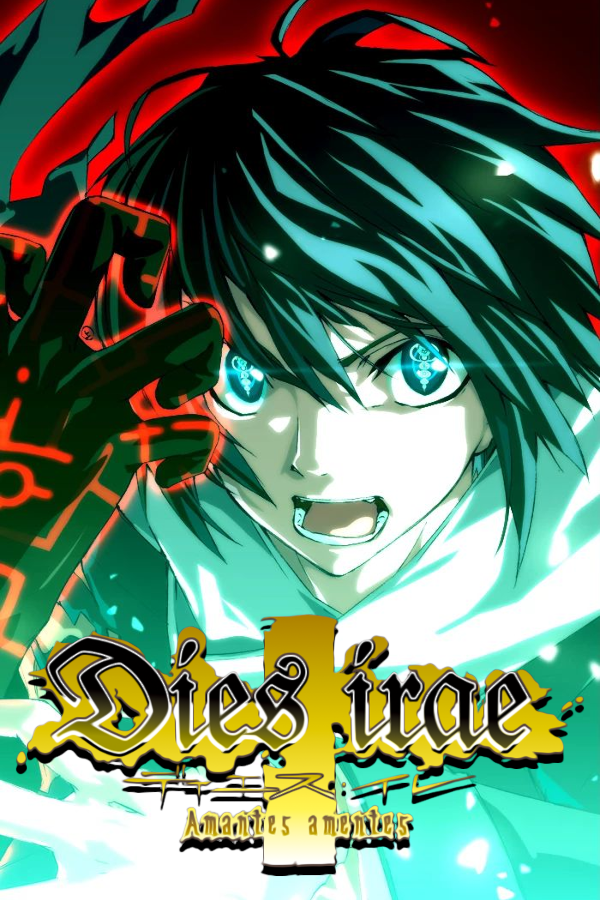Dies Irae Amantes Amentes December 24, 2018 in Video Games / Views and Reviews tagged #SlayTheBackLog by S. Wilson Since it’s the holiday break and Steam is doing their annual winter sale, I decided I needed to burn through some of my PC backlog before I was allowed to buy anymore PC games.
- Dies Irae Vndb
- Dies Irae Amantes Amentes Darkside Pc Game
- Dies Irae Amantes Amentes Download
- Dies Irae Amantes Amentes Guide
- Dies Irae Amantes Amentes Or Acta Est Fabula
Dies irae ~Amantes amentes~. 声优: 生天目仁美 瑞沢渓 鳥海浩輔 結下みちる 榊原ゆい 安元洋貴 寺島拓篤 成田剣 羽吹梨里 いのくちゆか 牧野芳奈 矢口アサミ 環有希 前田剛 はらさわ晃綺 諏訪部順一 谷山紀章. 介绍: 有 攻略: 1 下载: 6. Dies irae Amantes amentes Windows 10 Renewal Package Edition: 2016-12-02: 15+ Dies irae Amantes amentes iOS Edition: 2017-09-29: 18+ Dies irae Acta est Fabula.
The Dies irae 〜Amantes amentes〜 makes it possible that you can basically receive an unlimited quantity of in-App Purchases for Dies irae 〜Amantes amentes〜 within just with 3 minutes of time and very little effort at almost all. The Dies irae 〜Amantes amentes〜 Cheat is completely unengaged to use and you’ll generate as much in-App Purchases when you desire. Dies irae Amantes amentes For Nintendo Switch NSP XCI. Posted on January 2, 2021 January 2, 2021 by admin Categories NSP, Switch, Torrent, XCI. Release Year: December.
I recently finished reading the highly praised epic Dies irae, and what an epic it was. While a lot of it feels nothing more than action and redundant, generic speeches, there is a lot more going on beneath the surface of the plot which does not get revealed until the latter half. Moreover, many have bestowed upon it the title of the best chuunibyou story ever written. Contrary to what probably the vast majority of Western anime fans may believe, the chuuni genre is hardly limited to teenagers glorifying the idea of superpowers and magic words. Rather the genre itself is one which glorifies anything in the name of awesome for the sake of awesome. Rather than trying to be serious about the logic of the powers and plot, it instead has self-awareness about its own absurdity and plays that up even more. And so with stories like Dies irae, the superpowers are completely real, the stakes are as ridiculous as what they claim, and chanting psalms to unleash your true power is an absolute requirement – all because it’s cooler that way and nothing more. Even so, Dies irae rises above the rest of chuuni stories as being something that is incredibly well written. The prose is so elegant and grandiose, reflecting in its annals the embellished glorification of superpowers, and the English localization masterfully translates this immersive tone to the spectators of the Grand Guignol.
Before delving into the prophesized Day of Wrath, it is necessary to understand that Dies is heavily influenced by Also sprach Zarathustra by Friedrich Nietzsche, as many of the characters, themes, and ideas are directly based off it. To be completely frank, a fully accurate and fair analysis is something outside my range of knowledge and understanding. I could never hope to do a proper philosophical analysis of it as it pertains to Christianity. But simultaneously, we must remember that Dies is also the pinnacle of the chuuni genre – a genre that is not supposed to be taken seriously. Thus, it is this comical dichotomy that creates a story engrossed in philosophy yet meaningless in its delivery. Any outlandish interpretation we choose to make of it can therefore be argued as viable not because that is what the work is about but because making such a claim would in the spirit of the work. In other words, the genre is not about speaking in red but speaking in gold. It is not about stating the truth but about creating your own truth.
To give a quick and horribly simplified summary of Also sprach Zarathustra and Nietzsche’s philosophy, it includes a harsh critique about Christian theology. Zarathustra is a man who speaks of the ubermensch, an individual who journeys to master himself and has complete power over himself. Humans are but the transition between monkey and ubermensch. Furthermore, the universe is always in flux and changing; nothing is fixed. Therefore, the ideas of an unchanging God and an absolute truth and even a fixed morality are all false. To be misguided by something claiming to be unchanging is to fail as an ubermensch. Finally, the universe is always recurring in a phenomenon known as the eternal recurrence. An ubermensch accepts this for he has no regrets in life and would be delighted to repeat anything in life no matter how much suffering it entails, going as far as to even laugh in the face of hardship. Therefore, the idea of heaven or hell after your life ends is an idea for the weak, those who cannot accept the reality of the present. To desire an end is to run from the truth of eternal recurrence. Okay, that is far from an acceptable summary, but these ideas are critical to understanding Dies irae and the following explanation.
Now I must summarize a 50 hour long VN in a short paragraph. Ren, the protagonist of our story, is forced to gain supernatural powers and fight against superpowered Nazis or let the world be destroyed by their leader. He is given the name Zarathustra and as an ubermensch, is able to alter the world around him with his own desires, by his own powers, as are the antagonists. Skipping over a million plot points, he will find himself facing off against the two leaders of the remnant Nazis: Reinhard the Beast and Mercurius the Serpent, references that are far from a coincidence. In the world of Dies irae, Mercurius is an enigmatic figure whose true nature is the god of the world who achieved the highest level an ubermensch can and paints the laws of the universe with his dearest wish: eternal recurrence. In the end, Ren puts an end to both The Beast and The Serpent, ending the eternal recurrence. His partner Marie takes the Throne of the universe and paints over the Law with her desire to envelop every person with her love. Wow I butchered that summary too but these are the key points I need to comprehend things
In Nietzsche’s work, Zarathustra accepts the eternal recurrence, but Ren destroys it. In other words, Dies irae can be viewed as a criticism of Nietzsche’s criticism of Christianity. The eternal recurrence which he speaks of is but a farce and ended by one who carries the very name of Nietzsche’s prophet-like protagonist. Furthermore, the eternal recurrence is created by The Serpent, who symbolizes Temptation. In other words, in the world of Dies, eternal recurrence represents the cycle of sin as we constantly repeat the folly of our own actions (No doubt Taichi’s Channel has a thing or two to say about this). Indeed, the characters constantly refer to this phenomenon of eternal recurrence, stating they already have foreknowledge of a situation even if it is the first time they have experienced it. For the cycle of sin is the repetition of our folly and though we have foreknowledge of it, we still sin even while knowing exactly how it will go.
If Mercurius the Serpent represents Temptation then Reinhard the Beast naturally represents Satan. It is important to note that Reinhard, The Beguiling Light, was a normal man until he encountered the Serpent, whose silver-tongued words tempted Reinhard down the path of becoming Mephistopheles. As you may recall, Lucifer was originally an angel of heaven, and it was only when he listened to the temptations of his pride that he became the Satan of today. Furthermore, Reinhard is constantly referred to as being incredibly handsome; he is said to be the most beautiful man the characters have ever laid eyes on. Yet again, this description is fully intentional to make a parallel to his Biblical identity. Although, above everything else, the story outright calls him the Devil, making it less symbolic and more literal. Alongside this blatant parallel to the Devil, Reinhard is depicted as the ideal ubermensch: he is someone who accepts and loves everything equally. He does not regret and he does not fear whatever befalls him. Even when faced with death, he merely laughs in amusement, exactly as Nietzsche describes an ubermensch should. As such, it is clear that Dies irae is depicting Nietzsche’s ideal as the Devil incarnate, the one who rules over Legion.
Finally, with the destruction of both Mercurius the Serpent and Reinhard the Beast, the Throne of the World of Emanation is usurped by Marie the goddess who envelops all with her love. Most notably is that she chooses to envelop all the antagonists including Reinhard with her love as well. Her love does not discriminate against anyone. Sound familiar? By putting an end to the cycle of sin, the laws of the universe are replaced with infinite love – God’s love for us. Nietzsche’s entire philosophy is undermined by a power even greater than eternal recurrence: Christianity. Viewing the world of Dies irae a little differently, one could even call it a microcosm of our spiritual lives wherein we are initially ruled by the emanation of temptation, and it is only after a long struggle that we are able to put God on the Korsia of our lives and escape the Ghetto. Indeed, the story which unfolds is revealed to be but a theatrical act directed by The Serpent who grew wary of the eternal recurrence created by his own desires. We too will grow weary of the cycle of sin which tempts as daily, for no gratification in life can fill the gaping hole in our lives but Christ. We seek an end to eternal recurrence yet simultaneously do not choose to break free of it ourselves, even if the power of formation is buried in our souls. It is when the one who sits on the Throne emanates love throughout our lives that we can finally put an end to the deceitful cycle of eternal recurrence. Ren’s rejection of the supernatural and his return to the ordinary is depicted as the equivalent of the return of Odysseus to his wife Penelope. It is only through similar struggles that we too can return home to be the bride of Christ.
It may be easy to argue that my interpretation of Dies irae is wrong, but in the context of a chuuni story, does it even matter? Making pseudo-intellectual claims is the entire basis of the genre; with Dies being what it is, my entire argument could only be wrong by not being ridiculous enough. By making the original story of Zarathustra the basis of Dies irae, Masada is discussing Christianity in the way only a chuuni would. For the Light of the world is what birthed the story which he penned. Therefore, let this be my Beri’ah, the manifestation of my desires in the real world, so I’ll say it in gold:
Dies irae is a criticism of Nietzsche’s criticism of Christianity
.
Dies irae: Amantes amentes – Game Walkthrough / Solutions and Completion Guide
Recommended Route Order

Recommended route order: Common (Chapters 1-6) –> Kasumi –> Kei –> Marie –> Rea
Follow the above route order, trust me. Otherwise you’ll ruin the story for yourself.
Okay, so here’s the thing. Before you start the game, you’re shown this screen:
If you’re a first-time player, make absolutely sure to pick “New Game” on the left. If you pick any of the heroine buttons on the right, the game will lock you onto said routes regardless of your dialogue choices.
Note 1: The Other Stories can be accessed from the main menu, under (you guessed it) Other Story. One thing to note is that “Omnia vincit Amor” is essentially a Marie route epilogue, while “Nihil difficile amanti”, in a similar fashion, provides an epilogue for Rea’s route. As such, I would recommend reading those two extra stories immediately after finishing their respective routes. As for the other three side stories, I’d recommend reading “Wehrwolf” after finishing Kasumi’s route, then “Die Morgendämmerung” and “Verfaulender segen” after completing Kei’s route.
Note 2: Rea’s route has two endings. Go for Ending 1 first (“danced to the… etc.), then Ending 2 (…sought the truth) afterwards for the optimal reading experience. Also, make absolutely sure you follow the walkthrough very closely. Particularly in Rea’s route, you need to pick “Look for Rusalka”, “Trust Rusalka” and “Rescue Rea Himuro”, otherwise you won’t see some very important optional scenes.
Note 3: You can press F7 in-game to immediately jump to the next choice, while F6 will take you back to the previous choice.
Common / Kasumi Ayase
I was lying, you idiot
Try to persuade her
Take a look
Other Story “Wehrwolf” unlocks after Chapter 1
Explore the church
Dies Irae Vndb

Don’t give my name
Look for Sakurai
*pick every question when talking to Rusalka: What are you people? – What’s Zarathustra? – Where’s that other guy? – Why’d you come to this city? – What do you plan to do with me?*
…All right.
There’s no way in hell I can do that
Save 1
Drag Kasumi away
Disappear right now
To fight

Run away from Sakurai
Can’t even consider!
Other Story “Die Morgendämmerung” unlocks after Chapter 6
Save 2
Suppress the tattoo
Kasumi END
Kei Sakurai
From Save 2
Ask Sakurai about what’s going on
Sakurai

Never give up
Kei END
Other Story “Verfaulender segen” unlocks
Marie
From Save 1
Drag Sakurai away
Hide right now
To protect her
Kill Sakurai
Can’t even consider!
Marie END
Other Story “Omnia vincit Amor” unlocks
Rea Himuro
*Start a new game*
The jailbait stuff, I guess
Run away
Go home
Go to the chapel
Don’t give my name
Look for Rusalka
*pick every question when talking to Rusalka: What are you people? – What’s Zarathustra? – Where’s that other guy? – Why’d you come to this city? – What do you plan to do with me?*
What do you think?
Do I have no other choice?
Drag Sakurai away
Hide right now
To fight
Kill Sakurai
Will never do!
Trust Rusalka
Rescue Rea Himuro
Dies Irae Amantes Amentes Darkside Pc Game
The truth about my being
Save 3
…danced to the mercurial tune
Rea END 1
From Save 3
Dies Irae Amantes Amentes Download
…sought the truth
Rea END 2

Other Story “Nihil difficile amanti” unlocks
Extra Notes
In the Other Story “Nihil difficile amanti”, you will be faced with a choice at one point. These lead to two different variations of the scene, so make sure to pick both choices if you want to see everything.
Dies Irae Amantes Amentes Guide
Dies Irae Amantes Amentes Or Acta Est Fabula
